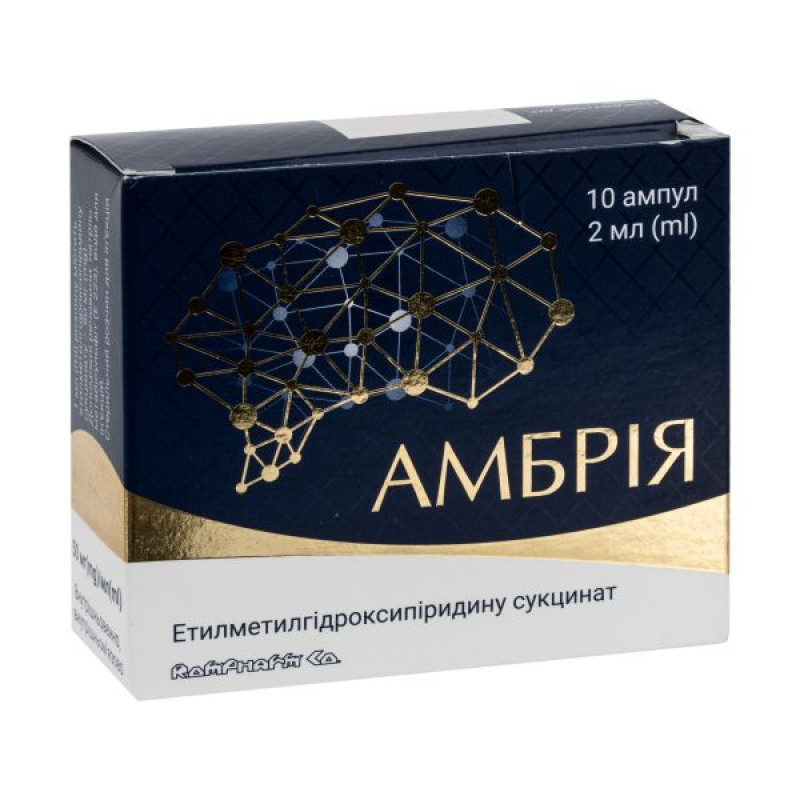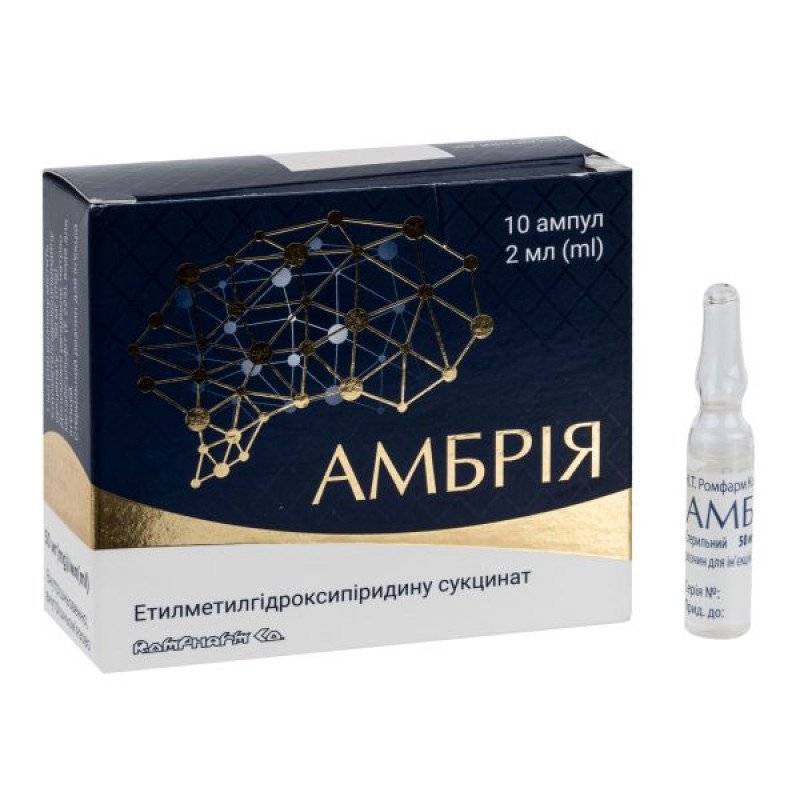Ambria solution for injection 50mg/ml ampoule 2 ml No. 10

Instructions Ambria solution for injection 50mg/ml ampoule 2 ml No. 10
Composition
active ingredient: ethylmethylhydroxypyridine succinate;
1 ampoule contains ethylmethylhydroxypyridine succinate 100.0 mg;
Excipients: sodium metabisulfite, water for injections.
Dosage form
Solution for injection.
Main physicochemical properties: colorless or pale brown solution.
Pharmacotherapeutic group
Drugs that affect the nervous system.
ATX code N07X X.
Pharmacological properties
Pharmacodynamics.
The drug has antihypoxic, antioxidant, membrane-protective, nootropic, anxiolytic, stress-protective, and anticonvulsant effects.
The drug increases the body's resistance to the action of various harmful factors, to oxygen-dependent pathological conditions [shock, hypoxia and ischemia, trauma, cerebral circulation disorders, intoxication with alcohol and antipsychotics (neuroleptics)]. The drug improves cerebral metabolism and blood supply to the brain, microcirculation and rheological properties of blood, reduces platelet aggregation. Stabilizes the membrane structures of blood cells (erythrocytes and platelets) during hemolysis. Has a hypolipidemic effect, reduces the content of total cholesterol and low-density lipoproteins (LDL). Reduces enzymatic toxemia and endogenous intoxication in acute pancreatitis.
The mechanism of action of the drug is due to its antioxidant and membrane-protective effect. It inhibits lipid peroxidation, increases the activity of superoxide dismutase, increases the lipid-protein ratio, reduces membrane viscosity, and increases its fluidity. Modulates the activity of membrane-bound enzymes (calcium-independent phosphodiesterase, adenylate cyclase, acetylcholinesterase), receptor complexes (benzodiazepine, gamma-aminobutyric acid (GABA), acetylcholine), which enhances their ability to bind to ligands, contributes to the preservation of the structural and functional organization of biomembranes, the transport of neurotransmitters, and the improvement of synaptic transmission. The drug increases the content of dopamine in the brain. Causes increased compensatory activation of aerobic glycolysis and a decrease in the degree of inhibition of oxidative processes in the Krebs cycle under conditions of hypoxia with an increase in the content of adenosine triphosphate (ATP) and creatine phosphate, activation of energy-synthesizing functions of mitochondria, stabilization of cell membranes.
Pharmacokinetics.
When administered intramuscularly, the drug is detected in the blood plasma within 4 hours after administration. The time to reach maximum concentration is 0.45−0.5 hours. The maximum concentration at doses of 400−500 mg is 3.5−4.0 μg/ml. The drug quickly passes from the bloodstream into organs and tissues and is quickly eliminated from the body. The drug is excreted from the body with urine, mainly in the glucuronide conjugated form and in small quantities in unchanged form.
Indication
- Acute cerebrovascular accident;
- traumatic brain injury, consequences of traumatic brain injuries;
- dyscirculatory encephalopathy;
- neurocirculatory dystonia;
- mild cognitive impairment of atherosclerotic genesis;
- anxiety disorders in neurotic and neurosis-like conditions;
- acute myocardial infarction (from the first day) - as part of complex therapy;
- primary open-angle glaucoma of various stages - as part of complex therapy;
- withdrawal syndrome in alcoholism with a predominance of neurosis-like and neurocirculatory disorders - cessation;
- acute intoxication with antipsychotic drugs;
- acute purulent-inflammatory processes in the abdominal cavity (acute necrotic pancreatitis, peritonitis) - as part of complex therapy.
Contraindication
- Acute hepatic or renal failure;
- increased individual sensitivity to the drug;
- childhood;
- pregnancy;
- breastfeeding period.
Interaction with other medicinal products and other types of interactions
Ambria enhances the effects of benzodiazepine anxiolytics, anticonvulsants (carbamazepine), antiparkinsonian drugs (levodopa). Reduces the toxic effect of ethyl alcohol.
Application features
Ambria contains sodium metabisulfite, which may rarely cause hypersensitivity reactions and bronchospasm. It should be used with caution in patients with diabetic retinopathy (the course of treatment should not exceed 7–10 days), as the drug potentiates proliferative processes.
After completion of parenteral administration, it is recommended to continue using the drug orally in tablet form to maintain the achieved effect.
Use during pregnancy or breastfeeding
Controlled clinical studies on the safety of the drug during pregnancy and breastfeeding have not been conducted. The use of the drug is contraindicated during pregnancy and breastfeeding.
Ability to influence reaction speed when driving vehicles or other mechanisms
During treatment, caution should be exercised when driving or operating complex machinery, given the likelihood of side effects such as drowsiness, which may affect reaction speed and ability to concentrate.
Method of administration and doses
Intramuscularly or intravenously (jet or drip). When administered by infusion, the drug should be diluted in isotonic sodium chloride solution. The drug should be administered slowly by jet over 5–7 minutes, drip at a rate of 40–60 drops per minute. The maximum daily dose should not exceed 1200 mg.
In acute cerebrovascular accidents, the drug should be used in the first 10–14 days - intravenously drip 200–500 mg 2–4 times a day, then - intramuscularly 200–250 mg 2–3 times a day for 2 weeks.
In case of dyscirculatory encephalopathy in the decompensation phase, the drug should be administered intravenously by jet or drip at a dose of 200–500 mg 1–2 times a day for 14 days. Then intramuscularly at 100–250 mg per day for the next 2 weeks.
For course prevention of dyscirculatory encephalopathy, the drug is administered intramuscularly at 200–250 mg 2 times a day for 10–14 days.
For mild cognitive impairment in elderly patients and anxiety disorders, the drug is administered intramuscularly in a daily dose of 100–300 mg per day for 14–30 days.
For alcohol withdrawal syndrome, the drug is administered at a dose of 200–500 mg intravenously or intramuscularly 2–3 times a day for 5–7 days.
In acute intoxication with antipsychotics, the drug should be administered intravenously at a dose of 200–500 mg per day for 7–14 days.
In acute purulent-inflammatory processes of the abdominal cavity (acute necrotic pancreatitis, peritonitis) the drug is prescribed on the first day both in the preoperative and postoperative periods. The doses depend on the form and severity of the disease, the prevalence of the process, and the clinical course. The drug should be discontinued gradually, only after a stable positive clinical and laboratory effect.
In acute edematous (interstitial) pancreatitis, the drug is prescribed at 200–500 mg 3 times a day, intravenously drip (in isotonic sodium chloride solution) and intramuscularly.
Mild necrotizing pancreatitis - 100–200 mg 3 times a day intravenously drip (in isotonic sodium chloride solution) and intramuscularly.
Moderate severity - 200 mg 3 times a day intravenously drip (with isotonic sodium chloride solution).
Severe course - in pulse dosage of 800 mg on the first day, with a twice-daily administration regimen; then - 200–500 mg 2 times a day with a gradual decrease in the daily dose. Very severe course - in the initial dose of 800 mg per day until stable relief of manifestations of pancreatogenic shock, after stabilization of the condition - 300–500 mg 2 times a day intravenously drip (in isotonic sodium chloride solution) with a gradual decrease in the daily dose.
Children
Strictly controlled clinical studies of the safety of the drug in children have not been conducted, therefore the drug should not be used in this category of patients.
Overdose
In case of overdose, sleep disorders such as insomnia may develop, in some cases drowsiness; with intravenous administration, in some cases, a short-term and slight increase in blood pressure is possible.
The development of overdose symptoms, as a rule, does not require the use of antihypertensive drugs. These symptoms of sleep disturbance disappear independently within a day. In especially severe cases, the use of one of the tableted hypnotics and anxiolytics (nitrazepam 10 mg, oxazepam 10 mg or diazepam 5 mg) is recommended. In case of excessive increase in blood pressure, antihypertensive drugs are used, controlling blood pressure, and/or supplementing therapy with nitro-containing drugs.
Treatment is detoxification therapy.
Adverse reactions
From the cardiovascular system: increased blood pressure, decreased blood pressure.
From the nervous system: weakness, dizziness, drowsiness, sleep disturbance, feeling of anxiety, emotional reactivity, headache, coordination disorder.
Gastrointestinal: nausea, dry mouth, flatulence, dyspeptic disorders, diarrhea.
On the part of the immune system: allergic reactions, including hyperemia, skin rash, itching, urticaria, angioedema, severe hypersensitivity reactions, bronchospasm.
Skin and subcutaneous tissue disorders: distal hyperhidrosis, injection site changes, peripheral edema.
With intravenous administration, especially jet, a metallic taste in the mouth, a feeling of heat throughout the body, an unpleasant odor, a scratchy throat and discomfort in the chest, shortness of breath, a feeling of palpitations, tachycardia, tremor, facial flushing may occur. As a rule, these phenomena are associated with excessive speed of administration of the drug and are short-term in nature.
Expiration date
3 years.
Storage conditions
Store in the original packaging at a temperature not exceeding 25 °C.
Keep out of reach of children.
The drug should not be mixed with other medications. Use only the solvents specified in the instructions.
Packaging
2 ml in an ampoule, 10 ampoules in a cardboard box.
Vacation category
According to the recipe.
Producer
K.T. Rompharm Company SRL / SC Rompharm Company SRL
Location of the manufacturer and address of its place of business
Eroilor str. No 1 A, Otopeni city, 075100, county Ilfov, Romania.
There are no reviews for this product.
There are no reviews for this product, be the first to leave your review.
No questions about this product, be the first and ask your question.











